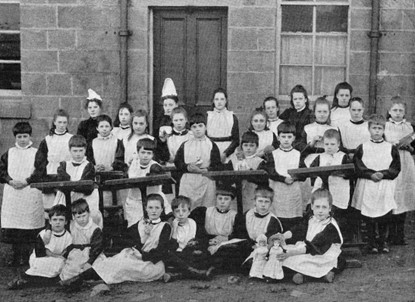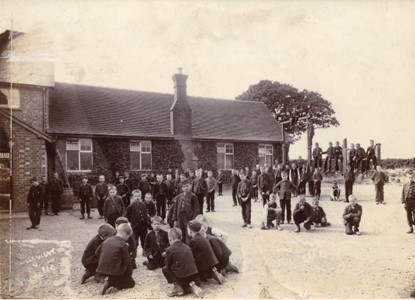‘I don’t know what they took me away for … I didn’t think I had done anything wrong at home and now I have lost everybody…’
During the nineteenth-century children could be taken into care by legal order through the criminal courts. Children were convicted under criminal legislation and consequently parents lost custody of their child to the state. Those children taken by law were detained in an industrial school, for the term of their committal. Committed children were rescued from abusive, neglected and dangerous environments, and this legal framework provided the basis for future child welfare legislation. The legal framework was created in the context of numerous changes in society, which included new political, social and cultural dimensions. New debates began to emerge around child welfare legislation underpinned by religion and class structures. There was a fear of the rise of the ‘underclass’ that would disrupt the moral fabric in society; removing children from environments seen by the authorities as unsuitable gave children the opportunity of an educational and moral upbringing and to avoid the negative parental influences. Emigration was seen as one of the best ways to provide a severance with the past.
When she was ten years old in 1886, Cecily, the author of the letter-extract cited in the title, appeared in court and was charged with being in the company of prostitutes. Cecily was committed to care and detained in the care of the Waifs and Strays Society (WSS) (now The Children’s Society), a major charitable organisation providing childcare for vulnerable children, until she was sixteen years old under Section 14 of the Industrial Schools Amendment Act 1880. She was sent to live in Cold Ash Industrial School, one of the WSS establishments. There appears no clear reason for her committal other than her association with prostitutes, a fact attributed to her mother’s neglectful care. Nonetheless Cecily was removed from her family, and in the process, her mother lost her parental rights; henceforth, Cecily’s future lay in the hands of the Secretary of State. During the same year Cecily was committed, in England 2,274 boys and 588 girls were committed to industrial schools, the majority under Section 14 of the Industrial Schools Act. The number of children committed to care incrementally increased throughout the century. Strict rules were applied to committed children and these rules affected their management of care.
Reading the applications of all 6824 children admitted to the WSS between 1882-1899 has given an insight into the reasons why children, both committed and uncommitted, were removed. Underpinning the removals were moral judgements and criticism of parental care. Contained within the children’s case notes are letters from committed children giving further insight into the impact of state removal. Forty-one years after her committal Cecily’s letter expresses guilt as she assumed she was ‘taken away’ because of something she had done, and because of this removal, she had lost her family and her identity. Cecily was not alone, others tell similar stories.

Days in the WSS industrial schools were filled with education, preparation for employment, domestic tasks, religious worship, and infused with moral training. Girls were prepared for employment in domestic service and boys in agricultural or practical trades. Contact with their parents was discouraged, as parental influences were thought to disrupt the work of the industrial school. Sometimes children’s names were changed, or they were known by a number. Life for a child in an industrial school was rigid and structured, with minimal contact with their past life.

Once children reached the age of fourteen, still under state jurisdiction, they were found employment placements, usually as servants in private homes found by the WSS staff. For some children, this was a pathway to independent living, but for others the experience was exploitative. Letters from the children to the WSS reveal how employers’ expectations of servants resulted in derogatory comments regarding their physical appearance, intellectual capabilities and low status in life and on occasions, physical abuse. Flora’s employer constantly referred to her as a ‘waif and stray’ which was hurtful and intimidating; Beatrice reported to the WSS that her employer had ‘boxed my ears’ so she left to return to her family in an unsatisfactory home. When employment placements failed the WSS tended to believe the employer, often suggesting the cause was the influence of children’s past-history. Those in charge expected subservience and gratitude, and this was generally accepted by the children. As the WSS had a legal responsibility to care for the children until they were sixteen, attempts were made to find further employment. In these circumstances some children drifted away and found their own solutions; others continued to receive help until they became self-sufficient, sometimes until they were eighteen, which was permitted under the law.
Adult committed children often had to contact the WSS for proof of identity, needing their birth certificate. Joseph requested background information on several occasions but his name had been incorrectly documented causing decades of delays and distress. During that time he had misconceptions about his mother’s identity; he wrongly believed his mother was a volunteer at his industrial school. Cecily never received any information about her family background and as her birth certificate was never found, she was advised to use her committal warrant as identification to claim her pension – a constant reminder she was criminalised. Dorothy spent much of her life wondering if anyone ever came looking for her, and Beth who was emigrated spent her life unable to make relationships, keep employment, felt inferior and unloved. Others wanted help to find their siblings who were separated when they were committed.
Besides needing official information, committed children also needed help when they had been discharged from care and were in vulnerable situations and desperate. The WSS had been the only stability in their lives and effectively their parent – they had no one else to turn to. Yet like today resources were stretched and priority was given to younger children in care. Whilst some children’s experience of state care was positive they still experienced stigmatisation, prejudice and an absence of their family history, still apparent today for Care Experienced children.
Further Reading
Annie Skinner, Behind Closed Doors: Hidden Histories of Children Committed to Care in the Late Nineteenth Century (1882-1899) (Oxford: Peter Lang, 2021)
Michelle Cale, ‘”Saved from a life of Vice and Crime”: Reformatory and Industrial Schools for Girls c1854-1900’, Unpublished D.Phil: Oxford University, (1993)
Pamela Cox, Bad Girls in Britain, Gender, Justice and Welfare, 1900-1950, (Basingstoke: Palgrave MacMillan, 2002, 2013)
Barry Godfrey, Pamela Cox, Heather Shore and Zoe Alker, Young Criminal Lives: Life Courses and Life Chances, (Oxford: OUP, 2017)
R. Dingwall, J.M Eekelaar and T. Murray ‘Childhood as a social problem: A Survey of Legal Regulation’ Journal of Law and Society (1984)
Carol Gear, ‘Industrial schools in England, 1857-1933 ‘moral hospitals’ or ‘oppressive institutions’? unpublished DPhil, University of London Institute of Education,(1999)
Marianne Moore, ‘Social Control or Protection of the child? The debates on the Industrial Schools Acts 1857-1894.’ Journal of Family History (2008)







